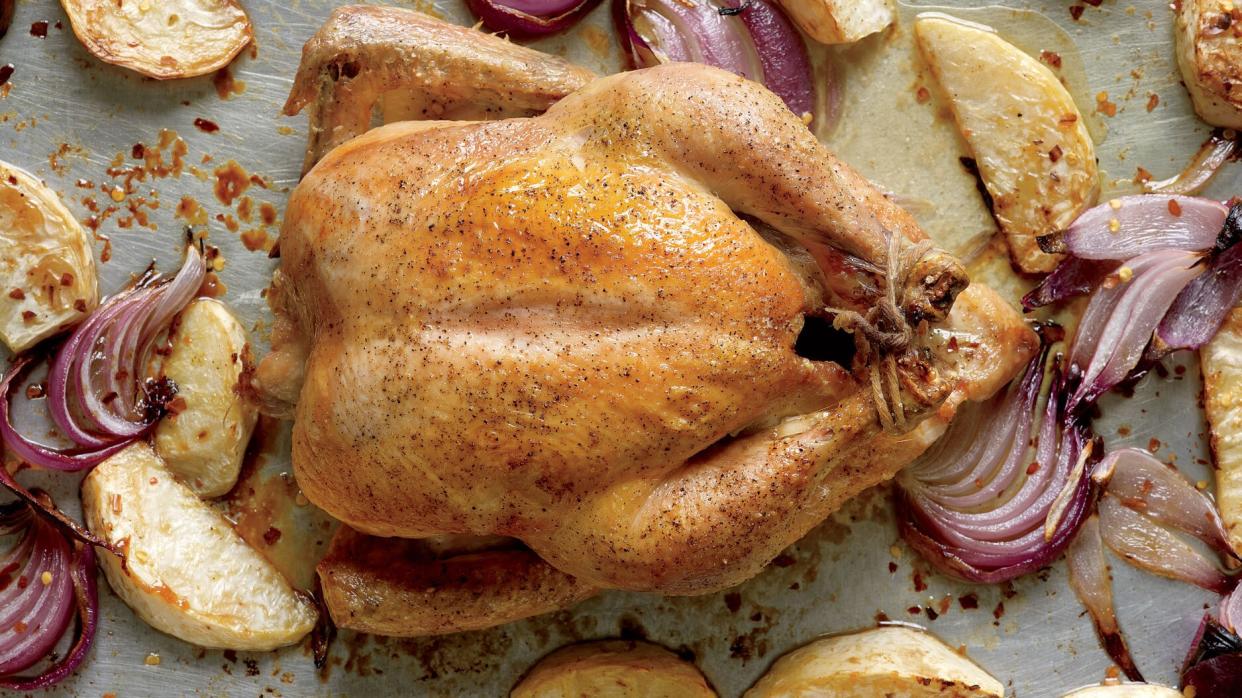What the Labels on Chicken at the Grocery Store Really Mean—and Which You Actually Need to Pay Attention To

Romulo Yanes
Chicken is economical and endlessly versatile, whether it's a sheet-pan chicken dish for an easy weeknight meal, or a chicken fricassee that's so beautifully made it's sure to impress your in-laws. The point is, a tasty chicken meal can be as simple or as complicated as you want. What should never be difficult is shopping for chicken, but all the packaging labels (from organic to free-range and beyond) can quickly complicate the situation. To simplify your next trip to the market, we've decoded what all the terms on chicken packaging mean in a handy cheat sheet.
The Terms You'll See on Chicken at the Grocery Store
Here we're explaining the terms you might find on chicken parts and whole chickens at your local supermarket. Our guide breaks down which are important and why you'll want to pay attention to them, and which labels you can and should ignore.
Animal Welfare Approved
Keep an eye out for this label as it tells you how farms treat chickens. Overseen by the nonprofit A Greener World (AGW), the Certified Animal Welfare Approved (AWA) label, which you'll mostly find on chickens from small, independent farms, means animals have continuous access to the outdoors and never confined to small cages. Chickens get to be chickens and peck around as much as they like. It also prohibits feedlots, hormones, and preventative or growth-promoting antibiotics and ensures that the transport and slaughter processes meet high-animal welfare standards too.
Antibiotic-Free/Raised Without Antibiotics
You'll also want to look for this label. It means that the chickens are raised without antibiotics or animal byproducts. This matters as antibiotics in meat production are one of the leading causes of resistant bacteria—and antibiotic resistance is "one of the biggest threats to global health," according to the World Health Organization.
Farm Raised
This means your chicken was raised on a farm, which basically all chickens are.
Free-Range
While labeling chicken as free-range means the chickens had outdoor access, there are no specifications on how much outdoor access they had or the quality of that time outside so it's not a label to look for when you're shopping for chicken.
Hormone-Free/Raised Without Hormones
In the U.S., poultry producers are required by federal law to raise chickens without hormones—so this label is reassuring, but not too significant.
Humanely Raised/Humane Certified
Chicken with this label must meet specific standards for animal care and slaughter. The nonprofit organization Humane Farm Animal Care oversees the labels auditing farms to ensure chickens have access to nutritious food, skilled, knowledgeable, conscientious animal care, and more. However, Humane Farm Animal Care does not prohibit feedlots or require outdoor access for chickens.
Organic
Regulated by the USDA's National Organic Program since 2002, all food labeled USDA Organic must be free of chemicals, most pesticides, sewage, sludge, and Genetically Modified Organisms (GMOs). When it comes to chickens, the label requires that birds are allowed year-round access to the outdoors, fed organic feed, and are not given drugs, antibiotics, and hormones.
Related: Beyond Organic, What Is Sustainable Food?
Natural
Labels that say "natural" on chicken generally mean that the chicken doesn't contain any colorings or preservatives, but it's a pretty meaningless term as there is no regulatory definition.
Non-GMO
This has become a popular label in recent years. The Non-GMO Project requires companies using this label to have a third-party administrator ensure their product contains less than 0.9 percent genetically modified (or engineered) organisms; basically, it means no material has been artificially manipulated in a lab. Keep in mind that organic and conventional products are eligible to be verified.
Pasture-Raised
This is a term to pay attention to, but also to be careful about as it's unregulated; make sure you're buying from a brand or farmer you trust. Pasture-raised birds basically live outdoors and use the access to shelter such as a barn at night. They have lots of room to roam and get to be chickens eating grass and seeds and other yummy stuff they would eat normally
Regenerative
A handful of organizations are working to create standards and labels around the term but at the moment there isn't one definition of what it means. The Regenerative Organic Alliance seal designed by Rodale Institute, Patagonia, and Dr. Bronner's, which includes a chicken producer certification, requires products to be organic and produced in a way that benefits farmers and promotes long-term soil health.
100 Percent Vegetarian Diet
When you see this term on packaging it means the chicken was fed feed free from animal byproducts but it isn't that useful when you're trying to work out which chicken is best for your family. Chickens aren't vegetarians naturally. They eat insects, even mice, snakes, and frogs if the opportunity arises.
Which Chicken Should You Buy?
Buy the best chicken you can afford that meets your values. Whenever possible, buy from your local farmer or at a farmer's market where you can ask questions such as how the birds are raised, what they are fed, whether they have access to the outdoors, what that space looks like, and whether they were exposed to antibiotics.

